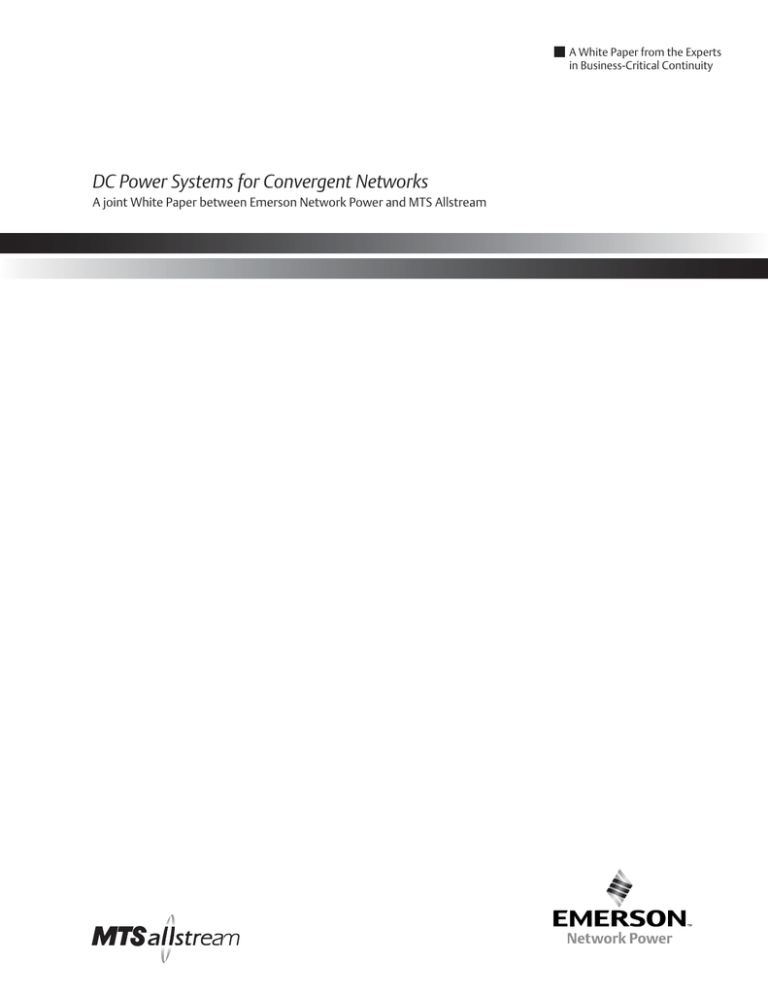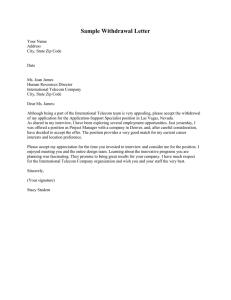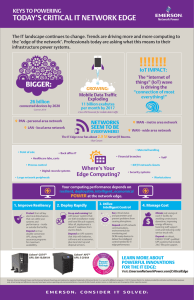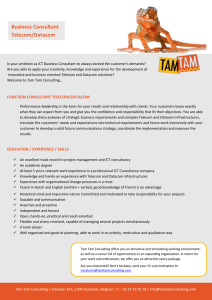
A White Paper from the Experts
in Business-Critical Continuity
DC Power Systems for Convergent Networks
A joint White Paper between Emerson Network Power and MTS Allstream
Communication is evolving. The distinction between telecom
networks and data centers is blurring, with facilities being built
housing equipment for both. Amidst the changes, there are new
concerns, new challenges, and some tough decisions that need
to be made – including choosing how to power those convergent networks.
This paper probes the differences between telecom and data center
power, examines the difficulties in powering equipment for convergent networks, and offers insights into the advantages of using
DC power for both telecom and data center equipment.
2
For decades, equipment for
datacom and telecom networks
has resided in different locations.
As more and more telecom networks carry datacom traffic and
equipment, the need for coexistence strategies has become
imminent – beginning with the
challenges in powering these
converged networks.
As voice, video, and data services continue
to drive the growth of telecommunications,
the evolving networks that bring these
offerings to market face new opportunities,
new challenges, and new dynamics.
The Messaging Industry Association
(TMIA) reports that from 2003 to 2006, US
residents 35 years and under have been
showing declining use of wireline phones1.
Roughly ninety percent of them had home
telephones in 2003; by 2006, the TMIA
survey indicates that those numbers were
ranging between sixty-eight and seventyfive percent.
Other independent studies2 estimate fixed
line penetration to decline from ninety-six
percent in 2005 to seventy-four percent by
2010. The forecast predicts the decline of
fixed lines as it faces increasing competition
from alternative, convergent technologies.
Meanwhile, video, voice, and data services
over the telecom infrastructure and Internet
Protocol (IP) are on the rise. Amidst the
changes, companies like MTS Allstream are
observing a significant market movement:
telecommunications networks are rapidly
evolving into systems carrying Internet, IP
telephony, and other data traffic in addition
to traditional voice telephony. The need to
adjust to the evolving market dynamics is
fueling a change in offerings and business
models. Just as the business models are
changing, the equipment requirements
are transforming with them.
Datacom industry equipment is typically
powered by AC mains with uninterruptible power supplies (UPSs). Telecom facility equipment is powered by DC power
plants with battery reserve power. As more
telecom operators house datacom equipment, the separation of power solutions
for telecom and datacom raises concerns.
Different power systems, service requirements, and grounding schemes results in
power backup, maintenance, and installation challenges.
Challenges with Powering
Convergent Telecom Networks
With telecom operators housing datacom
equipment, issues about reliability and
reserve time, distribution, grounding,
safety, installation, and maintenance come
into play.
Reliability and Reserve Time
During mains outages, AC backup power
for datacom and DC backup power for
telecom offer different reserve times, and
both directly affect a network’s reliability. For series-connected elements, the
lower reserve time sets the cap for reserve
power, this results in decreased service
availability. In a mixed power environment,
more batteries are used; and this potentially leads to more points of failure and
more parts to maintain.
While UPS technology has improved significantly over the past ten years, DC power
plants continue to be simpler as a system,
with fewer points that can fail.
1 Use of Home Phones in the US, 2003-2006, The Messaging Industry Association
2 US Fixed Telecoms Market Statistics, 2001-2010, Businesswire
3
In a typical telecom central office with a
permanent engine generator set (1,000kW
-2,000kW) and -48-volt DC power plant
(4,000A-10,000A) with three to four hours
battery autonomy, the system has comparatively few components (Figure 1.1).
A similar configuration for AC power, with
a permanent generator set (1,000kW2,000kW), AC UPS (100KVA-500KVA),
and switching equipment, would have a
few more components and a slightly more
complex configuration (Figure 1.2).
Figure 1.1
DC
R
CS
(n+1) Units
ATX
EG
Bat
Depending on tier requirements and budgets, hours of reserve time can be set up
for both AC and DC power systems. With
DC power plants, this means acquiring
additional batteries. For AC power, this
requires purchasing additional UPSs.
CS: Commerical Power Source
EG: Engine-generator Set
ATX: Automatic Transfer Switch
R: Rectifier
Bat: Battery
Installation, Maintenance, and Safety
AC and DC are grounded differently.
Implementation to meet safety standards
in a mixed power environment can be a
challenge. Different standards affect the
complexity of the process of grounding
equipment.
Installation in mixed power environments
is more difficult. Preventive maintenance
can be more tedious and more costly with
two power systems installed. Mean-timebetween-failures (MTBF) is reduced as the
surface area for faults and accidents rises
with complexity. Mean-time-to-repair
(MTTR) can be lengthened as the intricacies of the installation can make the source
of the problem harder to identify. Having
different power systems typically means
dealing with different suppliers, which may
add to the costs of maintenance contracts.
4
Figure 1.2
UPS
AC-DC
CS
DC-AC
AC
ATX
SWe
EG
Bat
CON
CS: Commerical Power Source
EG: Engine-generator Set
ATX: Automatic Transfer Switch
UPS: Uninterruptible Power Supply
Bat: Battery
SWe: Static Switch
CON: Control Circuit for SWe
Efficiency and Distribution
The capability to protect equipment from
disturbances on the commercial power
source, like transients, harmonic distortion, and high switching voltages, fundamentally vary for AC and DC power.
DC
DC power distribution entails that the commercial power source currents are isolated
from the equipment load – this is something inherent to the system’s architecture.
The commercial power source goes
through rectifiers and power is stored in the
batteries. When commercial power fails,
there are no switching processes involved,
and fewer points of failure – the equipment
load is carried by battery output.
Another advantage of DC distribution is
that DC power plants do not undergo as
many conversions as currents under AC
systems do, influencing power efficiency.
DC distribution, though, requires more
copper than does AC, and this has an
impact on cost.
AC
AC systems carry a considerable number
of challenges for distribution, perhaps the
most important being when the UPS is
bypassed, the system relies on protection
fitted to the bypass line, as current from
the commercial power source directly goes
to the equipment. This could mean highswitch voltages, transients, and harmonics
are not filtered properly before they reach
the equipment.
AC distribution requires more conversions
than does DC. Power efficiency is something that has improved with UPS systems
tremendously over the last few years, but
the conversions still reduce the efficiency
of AC systems. However, AC-powered systems carry less copper wire per rack.
DC Power Systems for
Converged Networks
Text: For new telecom sites with both
telecom and datacom equipment, setting
up a mixed power environment can be
more costly, less efficient, and significantly
more complex than just having one type of
power for the entire network. With mixed
power, safety becomes more difficult to
ensure, maintenance and installation are
that much more tedious, and more points
of failure are added to the system.
Choosing DC power for converged networks gives networks an array of benefits
over both mixed power environments and
AC power systems.
Cost-efficiency
MTS Allstream conducted a study showing costs associated with similar power
requirements for a new UPS system and
a -48-volt DC power plant upgrade supporting datacom and IP telephony growth
(refer to Table 1.1, page 6).
Data from the comparison shows that
provisioning a new UPS system cost more
than upgrading a -48V DC power plant.
On top of this, the typical scenario for
MTS Allstream DC power plants is that it is
maintained by in-house staff, while AC is
maintained by electrical contractors. The
latter has a significant impact on cost, and
adding UPSs cost significantly more than
adding batteries.
Reliability and Efficiency
MTS Allstream also conducted a separate
case study for AC and DC power for a recently
quoted central office (see Table 1.2,
page 6).
Both solutions are for new dedicated DC
or AC power systems within a segregated
space in a central office, with the same type
of utilities and a single generator backup.
The DC solution costs less, but the key
numbers to note are in the reserve time.
The DC option offers four times more
backup power than AC, for slightly less than
what it would cost to set up an AC system.
The reserve-time figures for DC under the
case study helps enable tier four uptime,
or 0.35 hour of downtime in five years.
Reserve time aside, DC systems utilize
power more efficiently than does AC.
Another company, NTT Facilities Inc.,
conducted studies in Japan on data center efficiency using AC and DC systems.
Their analysis indicated that data centers
achieve a 20 percent improvement in efficiency and a 10 percent reduction in cooling costs when DC systems are used3. DC
power plants can also utilize power management to switch rectifiers on and
off as the load changes, so system operation is at optimum all the time.
DC power is also exposed to less downtime
risks. The currents from the commercial
power source always get filtered; the
equipment is always galvanically isolated
from the mains. With AC, bypass operations can sometimes subject the equipment to transients and harmonics, in addition to the risks of switching failures when
the commercial power goes out.
3 Use of DC power for data centers in Japan
Keiichi Hirose, NTT Facilities, Inc.
5
Table 1.1 – Cost comparison between AC and DC from MTS Allstream study
Telecom/
Power Capacity
Data
(80% loading)
Unit Cost of AC vs. DC
Present Load
(Canadian dollars)
Center
AC
DC
AC
DC
Facility 1
325/(260)
6400/(5120)
201 kVA
3605 A
kVA
A
AC
DC
$186 k /
$80 k /1000
1000 A*
A**
Comments
* This system is for a new
65 kVA UPS system, or
48 V 10000A DC plant.
** Existing DC plants have
some spare capacity, cost
is shown for distribution of
1000 A only.
Facility 2
30/(24) kVA
2200/(1760)
23 kVA
1327 A
A
$143 k / 30
$95 k /
kVA*
500AA**
* Cost shown is for
30 kVA UPS.
** Cost shown are for upgrading DC plants including
distribution to cover additional 500 A requirement.
Table 1.2 – AC and DC comparison from a case study on a central office
6
Power
Specifications
AC
2x200 kVA UPS
2xSTS
2xPDU
Total max load –
160 kVA or 128 KW
DC
-48 V 3000 Amp frame
15x48/200 A Rectifiers
Distribution
7xBattery strings
Total max load –
2124 A
Cost
Reserve Time
Space
$705,000
1 Hour
Approx. 800 -1000 sq ft
$600,000
4 Hours
Approx. 540 sq ft
(Canadian dollars)
Simplicity
Scalability
Summary
DC power plants are comparatively simpler than AC power systems. As DC power
plants only consist of paralleled rectifiers
connected to two or more battery strings,
there are fewer components and points of
failure. The plants do not require plans for
phasing. With DC, distribution originates
at the point where batteries are paralleled,
with only fuses or circuit breakers interposed. If the commercial power source
fails, the load gets its power from batteries, no switching takes place.
While both AC and DC systems can scale
to different power needs, DC systems
can do so with more control, and fewer
considerations. Large AC UPSs scale at
the module level; if the existing modules
are 200kW, then 200kW increments have
to be used for expansions. DC systems
use smaller building blocks and can more
closely match the actual load requirement.
This result to better efficiency and lower
initial capital spent. Also, DC systems can
be maintained by personnel with limited
power training; as more components get
added to scale to the organization’s power
requirements, the maintenance cost does
not increase significantly.
With voice, video, and data services driving the growth of telecommunications,
the need to reliably and efficiently power
convergent networks becomes a chief
concern. DC systems empower network
operators to provide just that – greater
cost-efficiency and higher reliability in
powering mixed equipment facilities.
There are also fewer points of power conversion in a DC system – this helps ensure
high power efficiency.
Footprint
Servers that use DC power do not require
power supplies for the extra conversion
needed in AC systems, and DC systems
require fewer batteries than AC. As the
number of equipment supported by the
power systems pile up, the space saved,
because DC systems require less components, amount to considerable footprint
savings. These can be used to house revenue-generating equipment.
Safety
AC mains with UPSs use higher voltage
DC power when converted, so more controls need to be put in place. This has a
bearing on the overall safety of the system.
On top of this, AC has fourteen different
voltages across the world, while the battery voltage for most telecom switching
equipment is -48 volts, as defined by bodies such as ETSI and ANSI. The -48-volt DC
standard allows technicians to work on the
conductor without special safety measures
and minimum risks.
7
Robert Szasz, Senior Manager Infrastructure Engineering
MTS Allstream
P.O. Box 6666
333 Main Street, Winnipeg, Manitoba R3C 3V6
Toll Free: 888-811-6301
Web: www.mts.ca
BJ Sonnenberg, Business Development Manager
Emerson Network Power
Energy Systems, North America
4350 Weaver Parkway, Warrenville, IL 60555
Toll Free: 800-800-1280 (USA and Canada)
Telephone: 440-246-6999 Fax: 440-246-4876
Web: EmersonNetworkPower.com/EnergySystems
Emerson Network Power.
The global leader in enabling business-critical continuity.
EmersonNetworkPower.com
AC Power
Embedded Power
Precision Cooling
Connectivity
Monitoring
Racks & Integrated Cabinets
DC Power
Outside Plant
Site Monitoring
Embedded Computing
Power Switching & Controls
Surge Protection
© 2007 Emerson Network Power Energy Systems, North America, Inc. All rights reserved.
This publication is issued to provide outline information only which (unless agreed by Emerson Network Power Energy Systems, North America, Inc.
in writing) may not be used, applied or reproduced for any purpose or form part of any order or contract or be regarded as a representation relating
to the products or services concerned. Emerson Network Power Energy Systems, North America, Inc. reserves the right to alter without notice the
specification, design or conditions of supply of any product or service.
The Emerson logo is a trademark and a service mark of Emerson Electric Co. Emerson Network Power is a division of Emerson Electric Co.
NetSpan™ is a trademark of Emerson Network Power Energy Systems, North America, Inc.
Code: PWP-081
September 2007




